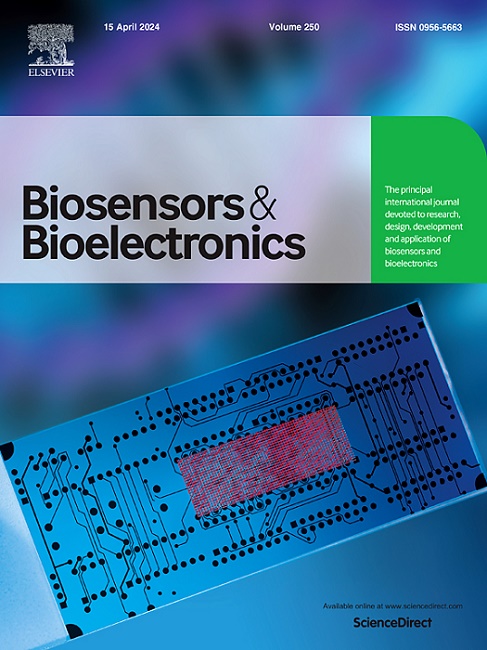Cyclometalated ruthenium (II) complex-based nanoparticles for enhanced microRNAs detection and imaging in living cells
IF 10.7
1区 生物学
Q1 BIOPHYSICS
引用次数: 0
Abstract
MicroRNA (miRNA) imaging in living cells is paramount for comprehending its dynamic functions and profiles, offering valuable insights into miRNA-related cellular processes. However, this remains challenging due to limited transfection agents and the low abundance of miRNAs. Herein, a smart nanosystem was proposed for miRNA imaging in living cells by ingeniously integrating cyclometalated ruthenium (II) nanoparticles (RuNPs) with a catalyzed hairpin assembly (CHA) strategy. Three cyclometalated ruthenium (II) complexes were synthesized and employed self-assembly technology to construct RuNPs. After evaluating their loading efficiency (LE), fluorescence quenching rates (QE), and fluorescence recovery rates (RE) for Hairpins, RuNPs-1 was selected to construct the Hairpins@RuNPs-1 nanosystem. With a detection limit of 1.5 pM, the Hairpins@RuNPs-1 nanosystem demonstrated high sensitivity for miR-25, live cell imaging confirmed its ability to detect intracellular miR-25 and differentiate its expression in various cells with excellent biocompatibility. We believe it has the potential to become an effective tool for nucleic acid research and would be poised to significantly influence the diagnosis and treatment of diseases.
环金属化钌(II)复合物基纳米颗粒增强活细胞中microrna的检测和成像。
活细胞中的MicroRNA (miRNA)成像对于理解其动态功能和特征至关重要,为miRNA相关的细胞过程提供了有价值的见解。然而,由于转染试剂的限制和mirna的低丰度,这仍然具有挑战性。本文提出了一种智能纳米系统,通过巧妙地将环金属化钌(II)纳米颗粒(RuNPs)与催化发夹组装(CHA)策略整合,在活细胞中进行miRNA成像。合成了三种环金属化钌配合物,并采用自组装技术构建了runp。在评估了它们在Hairpins上的负载效率(LE)、荧光猝灭率(QE)和荧光回收率(RE)后,选择RuNPs-1构建Hairpins@RuNPs-1纳米体系。Hairpins@RuNPs-1纳米系统的检测限为1.5 pM,对miR-25具有很高的灵敏度,活细胞成像证实了其能够检测细胞内miR-25并在各种细胞中分化表达,具有良好的生物相容性。我们相信它有潜力成为核酸研究的有效工具,并将对疾病的诊断和治疗产生重大影响。
本文章由计算机程序翻译,如有差异,请以英文原文为准。
求助全文
约1分钟内获得全文
求助全文
来源期刊

Biosensors and Bioelectronics
工程技术-电化学
CiteScore
20.80
自引率
7.10%
发文量
1006
审稿时长
29 days
期刊介绍:
Biosensors & Bioelectronics, along with its open access companion journal Biosensors & Bioelectronics: X, is the leading international publication in the field of biosensors and bioelectronics. It covers research, design, development, and application of biosensors, which are analytical devices incorporating biological materials with physicochemical transducers. These devices, including sensors, DNA chips, electronic noses, and lab-on-a-chip, produce digital signals proportional to specific analytes. Examples include immunosensors and enzyme-based biosensors, applied in various fields such as medicine, environmental monitoring, and food industry. The journal also focuses on molecular and supramolecular structures for enhancing device performance.
 求助内容:
求助内容: 应助结果提醒方式:
应助结果提醒方式:


